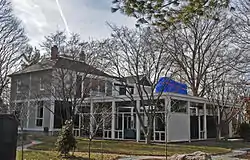Charles M. Goodman
Charles M. Goodman (November 26, 1906 – October 29, 1992) was an American architect who made a name for his modern designs in suburban Washington, D.C. after World War II. While his work has a regional feel, he ignored the colonial revival look so popular in Virginia. Goodman was quoted in the 1968 survey book Architecture in Virginia as saying that he aimed to "get away from straight historical reproduction."
Charles M. Goodman | |
|---|---|
 | |
| Born | November 26, 1906 New York City, New York |
| Died | October 29, 1992 (aged 85) Alexandria, Virginia |
| Nationality | American |
| Occupation | Architect |
Goodman, who designed the original National Airport outside of Washington, D.C. and served as main architect of the Hollin Hills neighborhood in Alexandria, Virginia, attended the Illinois Institute of Technology. He came to D.C. in 1934 to work as the designing architect in the Public Buildings Administration. He later served as head architect at the United States Treasury Department and the Air Transport Command. After World War II he worked closely with Robert C. Davenport designing and site planning most of the Hollin Hills, where his firm, Charles M. Goodman Associates, designed over 14 models of house.
Projects
Other projects included the 1964 Unitarian Church in Arlington, Virginia at 4444 Arlington Blvd. His residence, Goodman House, was built in 1954 at 514 Quaker Lane in Alexandria. In Reston, he designed a "cluster" of townhouses in the woods above Lake Anne known as Hickory Cluster. In the Southwest Waterfront Community of Washington, D.C. and just north of Fort McNair between N and O Streets and Delaware Avenue and 4th Street, SW, Goodman designed the glass and aluminum clad River Park Mutual Homes, which consists of two conjoined high-rise buildings and several clusters of flat and barrel-roof top townhouses. Reynolds Aluminum sponsored the development of River Park which explains the prominent use of aluminum in both its design and structure.
His 1949-51 development at Silver Spring, Maryland was listed on the National Register of Historic Places in 2004 as the Hammond Wood Historic District. His 1951 development at Takoma Park, Maryland was listed on the National Register of Historic Places in 2004 as the Takoma Avenue Historic District. His 1958-61 development at Silver Spring, Maryland was listed on the National Register of Historic Places, and is known as the Rock Creek Woods Historic District.[1] In 1957 he designed the Alcoa Care-free Home at Brighton, New York added to the National Register of Historic Places in 2010.[2] He also designed 21 twin dwellings in the High Point section of the Virginia Heights Historic District.[3]
Gallery
 Charles M. Goodman House, listed on the National Register of Historic Places (NRHP)
Charles M. Goodman House, listed on the National Register of Historic Places (NRHP) National Airport, now known as Ronald Reagan Washington National Airport
National Airport, now known as Ronald Reagan Washington National Airport Houses in the Takoma Avenue Historic District
Houses in the Takoma Avenue Historic District Barrel-roof townhouses in the Southwest Waterfront neighborhood of Washington, D.C.
Barrel-roof townhouses in the Southwest Waterfront neighborhood of Washington, D.C. Unitarian Universalist Church of Arlington is listed on the NRHP
Unitarian Universalist Church of Arlington is listed on the NRHP
References
- "Hammond Wood Historic District". Maryland Historical Trust. Retrieved October 29, 2008.
- Robert T. Englert (January 2010). "National Register of Historic Places Registration: Alcoa Care-free Home". New York State Office of Parks, Recreation and Historic Preservation. Archived from the original on September 24, 2015. Retrieved October 1, 2009.
- Laura V. Trieschmann; Patti Kuhn; Elizabeth Breiseth; Ellen Jenkins; Saleh Van Erem; Jeanne Barnes (May 2007). "National Register of Historic Places Inventory/Nomination: Virginia Heights Historic District" (PDF). Archived from the original (PDF) on September 26, 2012. Retrieved May 30, 2013.
External links
- Subdivisions and Architecture Planned and Designed by Charles M. Goodman Associates in Montgomery County, Maryland
- Houston House Apartments, Houston, 1966
- Heart of Glass article from Washington, DC City Paper 2003
- Photos of River Park
- "Part modern, part farmhouse, Alexandria home is testament to architect Goodman," by Nancy McKeon, The Washington Post, February 18, 2011
- Library of Congress holdings of Goodman drawings
- Rock Creek Woods, a suburban development located in Montgomery County, Maryland just outside Washington, D.C., consists of 76 Contemporary houses nestled in a wooded valley between two creeks.